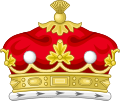| Marquessate of Milford Haven | |
|---|---|
 Arms of the 2nd Marquess | |
| Creation date | 7 November 1917 |
| Created by | King George V |
| Peerage | Peerage of the United Kingdom |
| First holder | Prince Louis of Battenberg |
| Present holder | George Mountbatten, 4th Marquess |
| Heir apparent | Henry Mountbatten, Earl of Medina |
| Remainder to | the 1st Marquess's heirs male of the body lawfully begotten |
| Subsidiary titles | Earl of Medina Viscount Alderney |
| Status | Extant |
| Seat(s) | Great Trippetts Estate |
| Former seat(s) | Lynden Manor Moyns Park |
| Motto | IN HONOUR BOUND |
Marquess of Milford Haven is a title in the Peerage of the United Kingdom.



